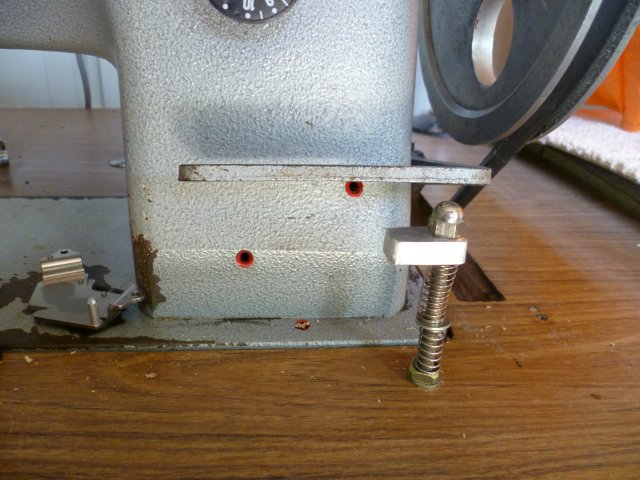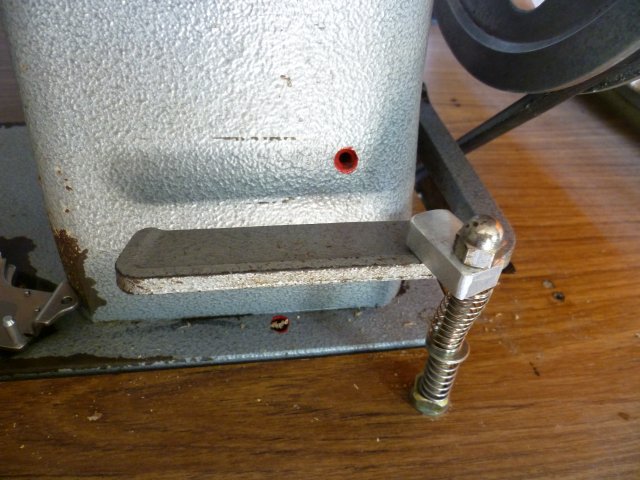-
Posts
4,808 -
Joined
-
Last visited
Content Type
Profiles
Forums
Events
Blogs
Gallery
Everything posted by dikman
-
You'd better look after that hubby of yours, sounds like a handy person to have around!
- 7 replies
-
- consew 220
- consew
-
(and 1 more)
Tagged with:
-
Has the lever been removed to stop anyone changing the stitch length?
-
I have a "calibrated stick" that I use for just that purpose on one of my machines .
-
As a matter of fact I do , but I was raised on manuals. I'm right-handed, but some things I do left-handed - swing an axe, baseball bat, cricket bat, golf club and use a fork in my right hand when eating. However, for accurate control of the go pedal on the sewing machine I really need to use my right foot. So there .
-
Thanks for the pics, always interested in forged, hand-made blades. I reckon if you'd left the filework off and thinned the guard down a bit then with just a bit more patina on the blade, along with the forging marks, it would pass as an old Mountain Man-type knife. I like the handle, nice bit of antler. Now, the real challenge is to make a sheath that reflects the knife, one that looks old and beat up with years of use! Nice thing about forging is that you can use all sorts of scrap metal to make things.
-
I thought of using the "pedal" approach, but I would need it on the left side of the "go" pedal ('cos I need to use my right foot to make it go). It started getting complicated because of the lever system needed. Mine might not win any "aesthetic/design" awards, but it works. On my Pfaff, where you lift the lever for reverse, I just cut a "calibrated" piece of wood to put under the lever (even simpler).
-
I recently discovered that I needed three hands trying to start stitching in reverse on my Seiko (tried holding my elbow across on the lever but didn't work too well). After coming up with all sorts of wonderful (and complicated) ideas, I reverted to the KISS principle. A hole drilled in the table, a piece of threaded rod, a suitably shaped chunk of aluminium, a couple of springs, nuts and washers. I used two springs 'cos my "spare spring" drawer didn't have one long enough (or soft enough). The lock flicks in and out easily, and what's more it works. Total cost = a couple of hours.
-
You can't say it's hand forged and not show a photo of the blade! That's what's known as a tease.
-

Singer 132K SV 11 -> a 132K6 variant?
dikman replied to Constabulary's topic in Leather Sewing Machines
That came up really nice - guess you won't be re-painting it? -

singer 111w155 Singer 111w155 feed lifting cam slop
dikman replied to kiddcaprix's topic in Leather Sewing Machines
Can definitely see wear in that first photo. -

singer 111w155 Singer 111w155 feed lifting cam slop
dikman replied to kiddcaprix's topic in Leather Sewing Machines
I just measured the clearance on my 111WSV77 and it's 10 thou total (being a 111 class I'd say the bottom end is going to be similar to yours). -

singer 111w155 Singer 111w155 feed lifting cam slop
dikman replied to kiddcaprix's topic in Leather Sewing Machines
Yeah, replacing that cam doesn't look like fun. -
Regardless of the pros and cons of doing it this way, it's a nice delicate job of welding! If I tried that I'd probably end up with a blob!
-

singer 111w155 Singer 111w155 feed lifting cam slop
dikman replied to kiddcaprix's topic in Leather Sewing Machines
The felt oiler is just that, a method of keeping an oil coating on the fork/cam contact area. I guess if it's been missing for a long time and the area hasn't been oiled then there may have been excessive wear? If there is wear then replacement would probably be the only answer (could be a big job, assuming you could get the parts!). Not something I've seen mentioned before. -

Singer 132K SV 11 -> a 132K6 variant?
dikman replied to Constabulary's topic in Leather Sewing Machines
So, after such a good find what are you going to do with the SV? -

Pfaff 4145 (combination of Pfaff 145 and Pfaff 4143)
dikman replied to Brtz's topic in Leather Sewing Machines
My first thought on seeing the brass block was also a knee lifter contact point, judging by the scratches on it.The blue knob is interesting as my Pfaff 335 has a position for such a fitting and I've always wondered what it would be used for.- 27 replies
-
- pfaff 4145
- pfaff 4143
-
(and 1 more)
Tagged with:
-

Singer 111W155 Alternating Presser Foot Problem
dikman replied to Wishful's topic in Leather Sewing Machines
Also slang for hitting someone. Mike, however, has pointed out the more common usage of the term. -
Well, if nothing else at least the paintwork is coming up nice!
-
Cbm, by following the adjustments in this thread you should be able to get it set right. It's actually not that difficult. Has someone been fiddling with the adjustments? It would be unusual for it to just "go out of adjustment", unless, of course, a screw has worked loose somewhere.
-
G'day Bert, welcome. That's an interesting looking machine (particularly from the back, lots of levers!).
-
They look pretty darn good to me, HC.
-

New (to me) machine for skate tongues
dikman replied to Hockeymender's topic in Leather Sewing Machines
Very nice! Always good to have new toys. -

2 gun rig for 5-1/2" SAA's
dikman replied to Josh Ashman's topic in Gun Holsters, Rifle Slings and Knife Sheathes
Actually, I just realised what it is about the thumb break that bothers me - it looks clumsy, and clashes with the style of the rig. Josh is to be thanked, as by doing this he has shown what NOT to do with western-style rigs. -

2 gun rig for 5-1/2" SAA's
dikman replied to Josh Ashman's topic in Gun Holsters, Rifle Slings and Knife Sheathes
Whilst I can appreciate the work that goes into stamping and carving, there's no denying the elegance of a simple, plain design that is well executed. As for the thumb break, if that's what the customer wants then that's what he gets - but sorry, it just doesn't look right to me. -
Thanks Wiz, I had been curious about that screw.




